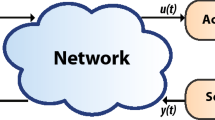Abstract
Wireless mesh networks begin to be used as an infrastructure of cyber-physical systems. A critical issue in developing wireless cyber physical systems (WCPSs) is the limited amount of energy available in the nodes. Energy consumption analysis can help designer to conduct a power-aware design process. In this paper, we propose a model based energy consumption analysis framework at architecture level for WCPSs. We extract event chains from the architecture model. With the energy consumption model for processing each type of event, we can estimate the energy consumption for each control loop and each node, as well as the overall energy consumption. All these energy consumption indexes can help us to design a performance and energy consumption balanced WCPS.












Similar content being viewed by others
References
Lu, C., Saifullah, A., Li, B., et al. (2015). Real-time wireless sensor-actuator networks for industrial cyber-physical systems[J]. Proceedings of the IEEE, 104(5), 1–12.
Song, J., et al. (2008). WirelessHART: Applying Wireless Technology in Real-Time Industrial Process Control. IEEE Real Time & Embedded Technology & Applications Symposium (pp. 377–386).
Petersen, S., & Carlsen, S. (2011). WirelessHART versus ISA100.11a: The format war hits the factory floor. IEEE Industrial Electronics Magazine, 5(4), 23–34.
Liang, W., et al. (2011). Survey and experiments of WIA-PA specification of industrial wireless network. Wireless Communications and Mobile Computing, 11(8), 1197–1212.
Yick, J., Mukherjee, B., & Ghosal, D. (2008). Wireless sensor network survey[J]. Computer Networks the International Journal of Computer & Telecommunications Networking, 52(12), 2292–2330.
Qiu, M., Chen, L., Zhu, Y., et al. (2014). Online Data Allocation for Hybrid Memories on Embedded Tele-health Systems[C]. High PERFORMANCE Computing and Communications, 2014 IEEE, Intl Symp on Cyberspace Safety and Security, 2014 IEEE, Intl Conf on Embedded Software and Syst. IEEE, pp. 574–579.
Zhu, X., Qin, X., & Qiu, M. (2011). QoS-aware fault-tolerant scheduling for real-time tasks on heterogeneous clusters[J]. IEEE Transactions on Computers, 60(6), 800–812.
Chen, L., Qiu, M., Dai, W., et al. (2016). Novel online data allocation for hybrid memories on tele-health systems[J]. Microprocessors & Microsystems. https://doi.org/10.1016/j.micpro.2016.08.003.
Qiu, M., Gao, W., Chen, M., et al. (2011). Energy efficient security algorithm for power grid wide area monitoring system[J]. IEEE Transactions on Smart Grid, 2(4), 715–723.
Hu, F., Qiu, M., Li, J., et al. (2011). A review on cloud computing: Design challenges in architecture and security[J]. Journal of Computing and Information Technology, 19(1), 25–55.
Bazzaz, M., Salehi, M., & Ejlali, A. (2013). An accurate instruction-level energy estimation model and tool for embedded systems[J]. IEEE Transactions on Instrumentation and Measurement, 62(7), 1927–1934.
Wang, X., & Xiang, J. (2009). Evaluation and improvement of an energy model for wireless sensor networks[J]. Chinese Journal of Sensors & Actuators, 22(9), 1318–1323.
Zhou, H. Y., Luo, D. Y., Gao, Y., et al. (2011). Modeling of node energy consumption for wireless sensor networks[J]. Wireless Sensor Network, 3(1), 18–23.
Zhang, Y., & Li, W. (2012). Modeling and energy consumption evaluation of a stochastic wireless sensor network[J]. EURASIP Journal on Wireless Communications and Networking, 2012(1), 1–11.
Kamyabpour, N., & Hoang, D. B. (2010). Modeling Overall Energy Consumption in Wireless Sensor Networks[J]. Computer Science, 273–279.
Slavik, M., Mahgoub, I., Badi, A., et al. (2011). Analytical model of energy consumption in hierarchical wireless sensor networks[C]. High-Capacity Optical Networks and Enabling Technologies. IEEE Xplore, pp. 84–90.
Konstantakos, V., Chatzigeorgiou, A., Nikolaidis, S., et al. (2008). Energy consumption estimation in embedded systems[J]. IEEE Transactions on Instrumentation and Measurement, 57(4), 797–804.
Lee, S., Ermedahl, A., Min, S. L., et al. (2001). An accurate instruction-level energy consumption model for embedded RISC processors[J]. ACM SIGPLAN Notices, 36(8), 1–10.
Kavvadias, N., Neofotistos, P., Nikolaidis, S., et al. (2004). Measurements analysis of the software-related power consumption in microprocessors[J]. IEEE Transactions on Instrumentation and Measurement, 53(4), 1106–1112.
Simunic, T., Benini, L., & Micheli G. D. (1999). Cycle-accurate simulation of energy consumption in embedded systems[C]. Design Automation Conference. Proceedings. IEEE, 1999, pp. 867–872.
Kobayashi, M., Miyazaki, H., & Masuda, Y. (2016). Energy estimation and optimisation of embedded systems using cycle accurate simulation[J]. Energy, 2002, 441– 442.
CC2420 Datasheet rev. 1.2[J]. (2004). http://www.chipcon.com/files/CC2420_Data_Sheet_1_2.pdf.
Levis, P., Madden, S., Polastre, J, et al. (2009). TinyOS: An Operating System for Sensor Networks[J]. In Ambient Intelligence, 383–396.
Chattefuee, S. (2003). Regression analysis by example[M]// regression analysis by example = (pp. 271–272). Beijing: China Statistics Press.
Pollin, S., Ergen, M., Ergen, S. C., et al. (2008). Performance Analysis of Slotted Carrier Sense IEEE 802.15.4 Acknowledged Uplink Transmissions[J]. pp. 1559–1564.
Wang, Y., Vuran, M. C., & Goddard, S. (2012). Cross-layer analysis of the end-to-end delay distribution in wireless sensor networks[J]. IEEE/ACM Transactions on Networking, 20(1), 305–318.
Acknowledgement
This work is supported by National Key R&D Program of China (Grant no. 2017YFB1200700), National Natural Science Foundation of China (Grant no. 61701007) and China Postdoctoral Science Foundation (Grant no. 2016M600865).
Author information
Authors and Affiliations
Corresponding author
Rights and permissions
About this article
Cite this article
Wang, P., Liu, J., Lin, J. et al. Model Based Energy Consumption Analysis of Wireless Cyber Physical Systems. J Sign Process Syst 90, 1191–1204 (2018). https://doi.org/10.1007/s11265-017-1306-y
Received:
Revised:
Accepted:
Published:
Issue Date:
DOI: https://doi.org/10.1007/s11265-017-1306-y




